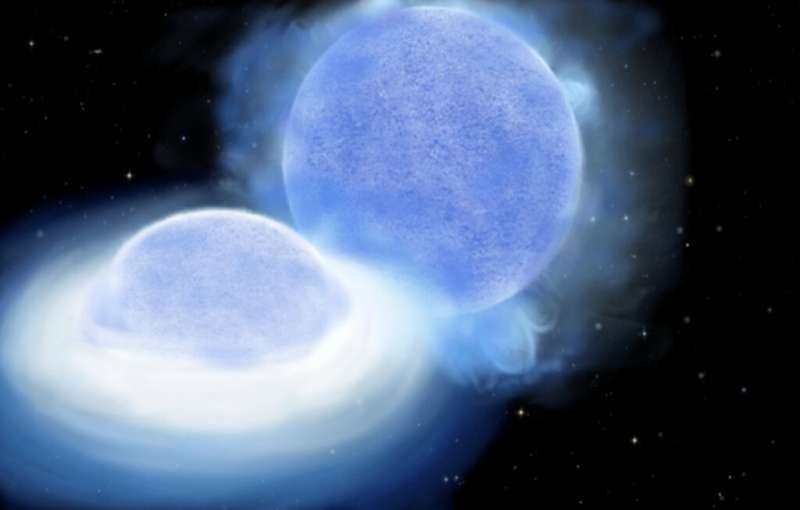This article has been reviewed according to Science X's editorial process and policies. Editors have highlighted the following attributes while ensuring the content's credibility:
fact-checked
peer-reviewed publication
proofread
Light supergiant reveals a missing evolutionary stage

Dr. Varsha Ramachandran from the Center for Astronomy of Heidelberg University (ZAH) and her colleagues uncovered the first "stripped" star of intermediate-mass. This discovery marks a missing link in our picture of stellar evolution toward systems with merging neutron stars, which are crucial to our understanding of the origin of heavy elements, such as silver and gold. Dr. Ramachandran is a postdoc in the research group of Dr. Andreas Sander, located at ZAH's Astronomisches Rechen-Institut (ARI). These results were now published in Astronomy & Astrophysics.
The team of researchers discovered the first representative of the long-predicted, but as yet unconfirmed population of intermediate-mass stripped stars. "Stripped stars" are stars that have lost most of their outer layers, revealing their hot and dense helium-rich core, which results from the nuclear fusion of hydrogen to helium. Most of these stripped stars are formed in binary star systems in which one star's strong gravitational pull peels off and accretes matter from its companion.
For a long time, astrophysicists have known of low-mass stripped stars, known as subdwarfs, as well as their massive cousins, known as Wolf-Rayet stars. But until now, they have never been able to find any of the so-called "intermediate-mass stripped stars," raising questions whether our basic theoretical picture needs a major revision.
By surveying hot and luminous stars with high-resolution spectroscopy devices of the VLT, the Very Large Telescope of the European Southern Observatory in Chile, Dr. Ramachandran and her colleagues detected suspicious signatures in the spectrum of a hot, massive star that previously had been classified as a single object. A detailed investigation of the spectrum revealed that the object is not a single star but actually a binary system, consisting of the intermediate-mass stripped star and a fast rotating companion, a so-called Be star that had been spun-up by accreting mass from the stripped-star progenitor.
The system is located in a neighboring dwarf galaxy called the Small Magellanic Cloud (SMC). Stars in this galaxy have a lower abundance of heavier elements, simply termed "metals" by astrophysicists, than the massive stars in our Milky Way. The metal-poor massive stars in the SMC therefore act as a window into the past of our own galaxy and the chemical evolution of the universe.

Dr. Ramachandran did her undergraduate studies in India, before moving to Potsdam, Germany for her Ph.D. Since September 2021, she has been working at ZAH/ARI. "With our discovery, we demonstrate that the long-missing population of such stars is actually there. But our findings also indicate that they might look very different from what we had expected," Dr. Ramachandran explains and adds that instead of having completely lost their outer layers, such stars may retain a small but sufficient amount of hydrogen on top of their helium cores, which makes them appear much bigger and cooler than they really are.
"We thus call them 'partially stripped stars,'" she adds. Dr. Andreas Sander points out that their mantle of remaining hydrogen is a form of disguise. "Partially stripped stars appear very similar to normal, non-stripped hot stars, thereby essentially hiding in plain sight. Only high-resolution data combined with careful spectral analysis and detailed computer models can reveal their true nature."
It is no surprise they have evaded detection for so long. "The particular giveaway of this star was its mass: a few times more massive than our sun may seem like a lot, but that is extraordinarily light for its blue supergiant appearance," the research group leader explains.
Dr. Jakub Klencki, an independent research fellow at the European Southern Observatory (ESO) and co-author of the respective research paper, explains that the newfound system serves as the critical link in the evolutionary chain connecting several different "species" of exotic objects. "Our stellar evolution models predict that in about a million years from now, the stripped star will explode as a so-called stripped-envelope supernova, leaving behind a neutron star remnant," Dr. Klencki says.
The discovery by Dr. Ramachandran and her colleagues marks the first such stripped star found to date in a metal-poor galaxy. If the binary survives the supernova explosion, the roles of the two stars will reverse: Then, the Be-star companion will donate mass to the neutron star accretor, becoming a so-called Be X-ray binary.
Such fascinating systems are considered to be the progenitors of double neutron star merger events, perhaps the greatest cosmic spectacles observed to date and the origin of chemical elements like silver or gold. Understanding their formation path is one of the main challenges of modern astrophysics, and observations of intermediate evolutionary stages are crucial to achieve this.
"Our discovery adds a major piece to the puzzle, yielding the first direct constraints on how mass transfer evolution proceeds in such massive star systems," Dr. Ramachandran concludes.
More information: V. Ramachandran et al, A partially stripped massive star in a Be binary at low metallicity, Astronomy & Astrophysics (2023). DOI: 10.1051/0004-6361/202346818
Journal information: Astronomy & Astrophysics
Provided by Astronomy & Astrophysics





















